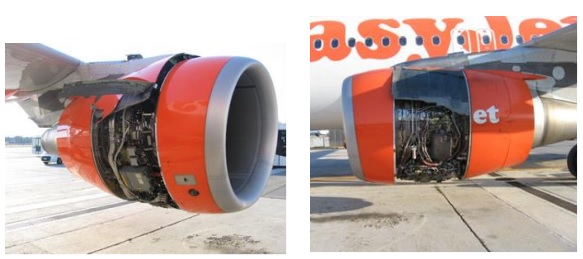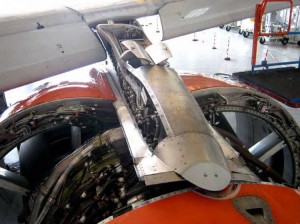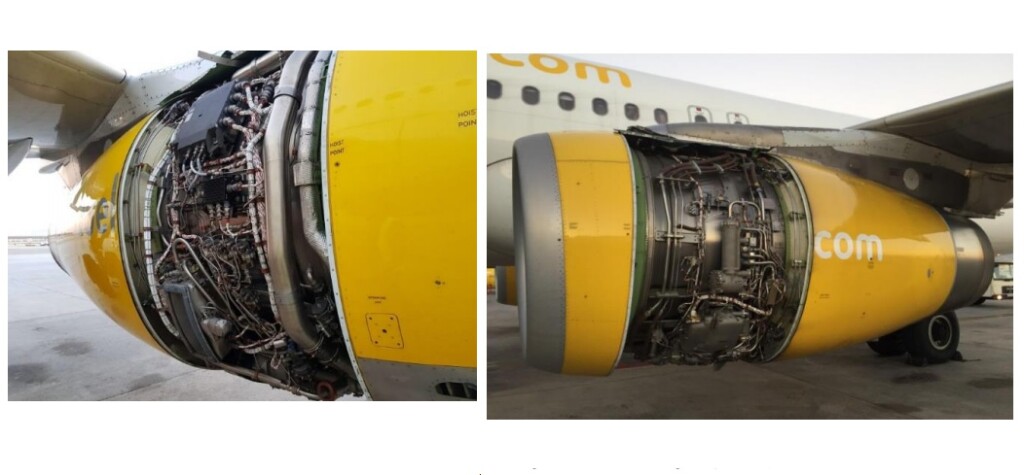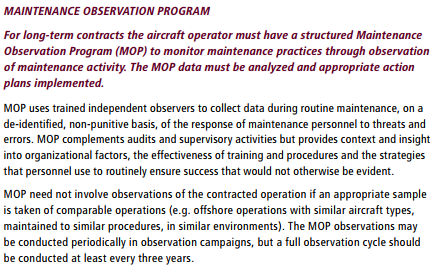ANSV Report on EasyJet A320 Fan Cowl Door Loss: Maintenance Human Factors
Italy’s Agenzia Nazionale per la Sicurezza del Volo (ANSV) has released its investigation report (in Italian) into the loss of both No 1Engine Fan Cowl Doors from a CFM56 powered EasyJet Airbus A320 G-EZTC on take-off at Milan-Malpensa Airport on 12 August 2013. The aircraft made a safe but overweight landing 17 minutes later, with some secondary damage to the fuselage and vertical stabiliser from debris impacts..
We had previous discussed the series of incidents with the Airbus A320 family cowlings and planned design improvements, in these articles:
- Maintenance Human Factors: The Next Generation, in which EasyJet discussed some of their actions after the Milan event
- A319 Double Cowling Loss and Fire – AAIB Report involving British Airways IAE V2500s powered A319, G-EUOE, at London Heathrow on 24 May 2013 (less than 3 months before the Milan event)
- A319 Double Cowling Loss and Fire – AAIB Safety Recommendation Update
We will not however cover the design issues further in this article.
Remarkably this was the 36th case of a fan cowl loss on the A320 family (14 on CFM56s and 22 on V2500s) since 1992. Aviation Safety Network records suggest 7 more occurrence since.
ANSV Investigation
After the British Airways event, Easyjet had issued various publications including a Notice to Crews and an Engineering Technical Instruction and had required an independent inspection after dual fan cowl opening.  EasyJet used a maintenance organisation at Milian with a German EASA Part-145 maintenance approval. Prior to the cowling loss a 63 year old Licensed Aircraft Engineer (LAE) with 42 years of experience had been tasked with investigating a report of an interphone interference that was occurring at No 1 engine start up.
EasyJet used a maintenance organisation at Milian with a German EASA Part-145 maintenance approval. Prior to the cowling loss a 63 year old Licensed Aircraft Engineer (LAE) with 42 years of experience had been tasked with investigating a report of an interphone interference that was occurring at No 1 engine start up.
It was suspected this might be due to a malfunction of an interphone socket at the No 1 engine. The LAE opened the cowl to check if it could be accessed (but without making a Tech Log entry). He then called a colleague for advice. The colleague advised an alternative way to access the interphone component. The cowling however remained unlatched.
The ANSV comment there was no particular urgency on doing the task but postulate that the high temperature (30ºC) may have effected human performance. The LAE also finished the task near the end of the fourth 12 hour (03:30 to 15:30) shift in a 4 day on, 4 day off shift pattern, which the ANSV postulate may have resulted in fatigue.
The ANSV suggest there was no evidence that the LAE took any technical data with him when working on the aircraft (though it is not clear if the LAE was actually asked what was being used).
The opening of the cowl to investigate the interphone component access is said to have resulted in breeching some of the procedural defences. The ANSV comment that the LAE was likely focused on the interphone task and comment on the lack of an error-proof cowl design. This would certainly account for why after the telephone conversation the cowlings were forgotten about (the ANSV classify this as a ‘lapse’).
The flight crew also did not spot the cowling was open as the Commander’s inspection was not “performed in compliance with the operator’s standard operating procedures” according to the ANSV, though the Tech Log entry for the interphone task would not have focused extra attention on the cowling. There is also a suggestion that the Commander may also have been affected by the heat, 2 hours of prior exercise and not having eaten since a light breakfast.
Latches are just 50 cm from the ground requiring verification kneeling or squatting and if the latches are engaged, but not locked, there is minimal visual indication as they are near flush. In the case of EasyJet aircraft the contrast is poor between the yellow latch and the orange cowling.
EasyJet subsequently took a lead in encouraging an error-proof design, utilising a ‘key’ with a streamer, normally stowed in the cockpit, that can not be removed unless the cowling is fully locked (discussed in our earlier articles). Two safety recommendations are made by ANSV. One is a rather odd and disproportionate recommendation that seems to imply the ASNV believe there is wide confusion on whether compliance with maintenance procedures is mandatory (EASA clarified that Part-145 is actually explicit in their comments on the draft, reproduced at the end of the ANSV report) and another on including crew actions after a cowl loss in the FCOM.
Airbus has published guidance on preventing leaving cowls unlatched.
UPDATE 16 December 2016: EASA issue AD 2016-0257 on CFM56 powered A320s for the Fan Cowl Door Latch with Key and Flag Modification. AD 2016-0053 on V2500 powered A320s had been issued in March 2016.
UPDATE 16 February 2017: Aerossurance is delighted to be sponsoring an RAeS HFG:E conference at Cranfield University on 9 May 2017, on the topic of Staying Alert: Managing Fatigue in Maintenance. This event will feature presentations and interactive workshop sessions.
UPDATE 27 August 2017: We look at the Singapore Transport Safety Investigation Bureau (TSIB) into the 16 October 2015 Tiger A320 Fan Cowl Door Loss & Human Factors
UPDATE 4 December 2017: United Airways Suffers from ED (Error Dysfunction). The US airline shows a strange grasp of human factors principles and argues AGAINST a human centred design change intended to address a long running series of maintenance errors.
UPDATE 21 January 2018: Human Factors of Dash 8 Panel Loss
UPDATE 25 January 2018: The NTSB release their report on Aruba Airlines A320-200, P4-AAA, which lost the outboard fan cowl from the right-hand V2527 engine during takeoff from Miami on 19 September 2016.
The night prior a routine weekly check was conducted by contracted maintenance organisation Miami Tech Aircraft Maintenance. This included opening the fan cowl doors to inspect the Integrated Drive Generator (IDG). Because the ramp area was dark, the mechanic who completed the work used a flashlight to verify the latches were flush and made sure he heard a click. A second mechanic verified that the latches were flush. The task was signed off in the Technical Log as complete but the Tech Log entry did not explicitly state that the cowls had been opened. The next morning both an airline maintenance supervisor and the first officer conducted walkarounds. Neither noticed any abnormalities. The FO stated he bent down and checked that it was cowling was flush and latched.
After this occurrence, Aruba Airlines reported to the NTSB that they had taken the following actions:
- Embodied modification Goodrich Service Bulletin V2500-NAC-71-0325, a 1999 SB for a hold open device (it surprising that this modification, albeit non-mandatory, was not in place)
- Maintenance personnel now ensure that an entry is made in the aircraft log to notify flight crews that the fan cowl doors were opened and closed to perform maintenance (surprisingly this was not already in place)
- Flight crews are now required to perform a close inspection of the latches when they see the log book entry and sign their compliance on the log book.
It is noteworthy that the NTSB report is disappointingly lightweight compared to the recent UK AAIB, ANSV and TSIB reports, with very little discussion of the HF aspects (though it could be argued this is a sign of a well understood problem).
UPDATE 11 March 2018: EC120 Forgotten Walkaround
UPDATE 24 June 2018: B1900D Emergency Landing: Maintenance Standards & Practices The TSB report posses many questions on the management and oversight of aircraft maintenance, competency and maintenance standards & practices after this serious incident. We look at opportunities for forward thinking MROs to improve their maintenance standards and practices.
UPDATE 25 August 2018: Crossed Cables: Colgan Air B1900D N240CJ Maintenance Error On 26 August 2003 a B1900D crashed on take off after errors during flying control maintenance. We look at the maintenance human factor safety lessons from this and another B1900 accident that year.
UPDATE 8 November 2018: a Vueling A320-200, EC-MDZ, lost the cowls from its left hand V2527 on take off from Bilbao. Debris became stuck in the left main landing gear without affecting retraction or lowering. Debris also punctured a fuselage fairing (images).
UPDATE 30 November 2018: A Frontier A320-200, N227FR, suffered a left hand CFM56-5B4/P cowling failure shortly after departing from Las Vegas (video). Of note is the thrust reverser C-duct, further aft, is also open.
UPDATE 5 September 2020: The Spanish air accident investigators, the CIAIAC, have issued their report on the 25 October 2018 loss of cowls from the V2500 powered Vueling A320 EC-MDZ. The cowl release also resulted in damage to cabling and sensors on the main landing gear leg. The causes are similar to the previous events. EASA AD 2016-53 for the fan cowl pin and flag had not been implemented on EC-MDZ at that time (compliance was due by 28 March 2019), although it was planned for November 2018. The Vueling fleet was fully complaint 2.5 months before the deadline and CIAIAC determined that this AD “significantly reduces the risk of improperly latched cowls in the future.
UPDATE 25 March 2023: Managing Interruptions: HEMS Call-Out During Engine Rinse
UPDATE 29 July 2023: Missing Cotter Pin Causes Fatal S-61N Accident
Aerossurance is pleased to be supporting the annual Chartered Institute of Ergonomics & Human Factors’ (CIEHF) Human Factors in Aviation Safety Conference for the third year running. We will be presenting for the second year running too. This year the conference takes place 13 to 14 November 2017 at the Hilton London Gatwick Airport, UK with the theme: How do we improve human performance in today’s aviation business?
Aerossurance worked with the Flight Safety Foundation (FSF) to create a Maintenance Observation Program (MOP) requirement for their contractible BARSOHO offshore helicopter Safety Performance Requirements to help learning about routine maintenance and then to initiate safety improvements:
Aerossurance can provide practice guidance and specialist support to successfully implement a MOP.
Aerossurance is pleased to be both sponsoring and presenting at a Royal Aeronautical Society (RAeS) Human Factors Group: Engineering seminar Maintenance Error: Are we learning? to be held on 9 May 2019 at Cranfield University.












Recent Comments